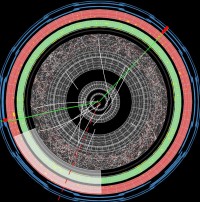By James Dacey
Who discovered the Higgs boson? Was it Peter Higgs and a combination of other great minds? The experimentalists at CERN who analysed reams of data? The magnificent machinery of the Large Hadron Collider (LHC) itself? By the time that the next great breakthrough in particle physics comes along, the debate about who makes the discovery could become even more complex. That’s because a new citizen-science project is encouraging anyone with an Internet connection to search for new curiosities in the Higgs data.
“Higgs Hunters” launched this week and invites the public to sift through collision images from the LHC’s ATLAS detector. The task at hand is to look for the paths of charged particles that seem to appear out of thin air in what are known as off-centre vertices. As explained on the Higgs Hunters website, “some scientists think the Higgs could break apart into exotic particles entirely new to science”. On the Higgs Hunters website, citizen scientists help to count the number of particle tracks and can notify the science team if they spot anything out of the ordinary.
The launch of the new project comes just days after CERN released its first public data produced by experiments at the LHC. “Launching the CERN Open Data Portal is an important step for our organization,” says CERN’s director general Rolf-Dieter Heuer. “We hope these open data will support and inspire the global research community, including students and citizen scientists.”
Higgs Hunters is the latest project in the Zooniverse, a citizen-science Web portal launched in 2009. The initiative grew out of the success of the Galaxy Zoo project launched in 2007, in which the public were invited to help astronomers with the classification of galaxies – a task that is best achieved with the human eye rather than computer algorithms. Today, the Zooniverse hosts a dozen projects across the sciences and the humanities, where the focus tends to be on the human ability to process patterns.
Yesterday, I caught up with the founder of the Zooniverse, the astronomer and broadcaster Chris Lintott. “We’ve discovered that people are not just capable of doing the tasks, but of using that beautifully human quality of being distracted by interesting and unusual things in all sorts of different directions,” he says.
Lintott explained that the Zooniverse has recently received a grant from Google to develop a new platform that will enable scientists to build their own citizen-science projects. At present, these portals are built and managed by the Zooniverse team. A trial version of this new platform will be launched in early 2015 so that researchers can see what it would be like to create a citizen-science project related to their area of interest.
Chatting with Lintott, I was interested in what he believes motivates people to take part in citizen-science projects, and to what extent he believes that these citizens are doing “science” instead of just data-processing. He says that the key to whether a Zooniverse project will be successful or not is that the supporting information can explain that connection between what you’re asking people to do and the bigger picture of the science. He describes the projects as “engines” to drive people to learn more about the underlying science.
Lintott also believes that these projects can provide the public with a more realistic view of what scientists do on a daily basis. “Science is about being in the field of collecting data, it’s about sorting through a million images, it’s about understanding that most of the usual stuff you find will have routine causes,” he says. “I think that is as much science as putting the full stop on the final line of a conclusion in a paper that’s gonna change the world.”
So, I would advise anyone reading this to have a go at the latest Zooniverse project and let us know what you think. Either add a comment below this post or let us know on Twitter using our handle @PhysicsWorld. In the meantime, I’m going to be putting together a podcast about citizen science based on my interview with Chris Lintott, which will be available on this website in early 2015.

Trackback: Physics Viewpoint | Become a CERN physicist in your bedroom
It is a good idea and opens the closed doors and hence wide participating of all human in the great CERN project. Thanks